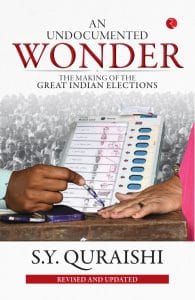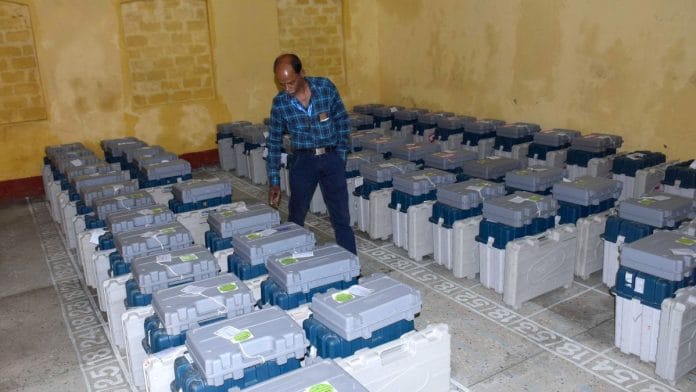The functioning of the ECI–EVMs was questioned before the Bombay High Court (Nagpur Bench) and the Karnataka High Court in two separate election petitions. Both the high courts examined some of the technicians and computer experts who were either produced by the parties or summoned by the court at length. Both the courts were satisfied about the non-tamperability of the ECI–EVMs.
The Karnataka High Court went to the extent of observing that ‘this (ECI–EVM) invention is undoubtedly a great achievement in the electronic and computer technology and a national pride’. The Kerala High Court also recorded its appreciation of the efficiency of the mechanism of the ECI–EVMs.
Controversies about EVMs
Early Controversies
- Before the elections in Tamil Nadu, Jayalalithaa Jayaram, General Secretary of the AIADMK, had written a letter to the Commission to discard EVMs and use paper ballots in the state assembly elections in 2001 on the grounds that electronic devices had failed miserably even in scientifically and technologically advanced countries like the US and Japan. She also filed a W.P. No. 3346 of 2001 in the High Court of Chennai. The case finally went to the Supreme Court where it was decided in favour of EVMs.
- Captain Amrinder Singh, President, Punjab Pradesh Congress Committee, raised objections in a petition before the Punjab High Court prior to assembly elections in 2002. He sent a team of experts to the Election Commission, as directed by the High Court, to examine the machines. The experts could not come up with any concrete objection even after detailed examination of the EVMs.
- Satinath Choudhary, a computer scientist in the USA and the President of Better Democracy Forum, could not demonstrate any tamperability of EVMs in a demonstration session on alleged tamperability of ECI–EVMs on 8 August 2009 in the premises of the Election Commission of India.
- A demonstration session on alleged tamperability of ECI–EVMs by one Haneefa (who, incidentally, wanted to promote his own machine) was held on 12 October 2007 in Bangalore. He could not demonstrate any malfunction or tamperability and was fined by the court.
Also read: These 80 Indians in America mounted the first protest against Indira Gandhi’s Emergency
Recent Controversies
- The Commission also received petitions from individuals raising doubts about the non-tamperability of EVMs. These include Kirit Somaiya of the Bharatiya Janata Party, G.K. Mani, President, Pattali Makkal Katchi, Omesh Saigal, retired Chief Secretary of Delhi, Subramaniyam Swami, President Janata Party and Satinath Chowdhery.
- Rashtriya Janata Dal, All Indian Anna Dravida Munnetra Kazhagam, Telugu Desam Party, All India Forward Bloc, Asom Gana Parishad, Communist Party of India, Communist Party of India (Marxist), Indian National Lok Dal, Janata Dal United, Janata Dal (Secular), Rashtriya Lok Dal, Revolutionary Socialist Party and Samajwadi Party wrote a letter to the Commission requesting an all-party meeting on EVMs. The BJP also made the same request in a separate letter. The Commission held an all-party meeting on 4 October 2010 in which EVMs were discussed along with three other issues—monitoring expenditure, paid news and criminalization of politics. Most of the political parties expressed satisfaction with EVMs. Some political parties requested the Commission that the Expert Committee may be asked to examine the feasibility of introducing a Voter Verified Paper Audit Trail (VVPAT) with the EVMs.
- A programme on a Telugu TV Channel TV-9 by V.V. Rao and Hariprasad made a demonstration of alleged tamperability of EVMs on an EVM allegedly stolen from the office of the DEO, Mumbai. An FIR for theft of public property was registered. The trial in the case is ongoing.
- The main points raised by people alleging tamperability and the reasons why these are not acceptable include:
-
- It has been alleged that there is a possibility of the presence of a Trojan horse in an EVM. However, there is no such possibility because the software code is secret and not readable by anybody. The software programmers are of very high integrity. EVMs are manufactured by reputed public sector organizations and have proved very reliable. Every EVM is subjected to rigorous checks before deployment in the presence of political party representatives.
- It has been alleged that there is lack of voter verifiability in EVMs. The fact is that the voter verifies his or her ballot by a beep and by a LED getting lit next to the candidate’s button on the BU once the button is pressed.
- Some people say that there is a lack of a possibility of recount. The fact is that a recount is possible any number of times. There will not be any variance in the result displayed as there are no human errors in machine counting.
- Possibility of change of components (hardware hacking) has been mentioned. The fact is that after FLC an EVM is sealed and its inside cannot be accessed, making hardware hacking impossible.
- It was shown on television that the display on an EVM can be controlled from another Bluetooth device by passing the data in the EVM. This is not possible in a real election because in a real election nobody has access to EVMs and it is not possible to introduce a Bluetooth device in an EVM because of administrative safeguards and security.
- It was shown in the same television programme that using a chip on the memory, one could access and change the data in the memory of the EVM. This cannot be done in a real election because nobody can access the memory in an EVM without breaking open all its seals. A broken seal can be easily identified. If a seal is found broken or damaged, the machine is not used.
 This excerpt from SY Quraishi’s ‘An Undocumented Wonder: The Making of the Great Indian Elections’ has been published with permission from Rupa Publications India.
This excerpt from SY Quraishi’s ‘An Undocumented Wonder: The Making of the Great Indian Elections’ has been published with permission from Rupa Publications India.






